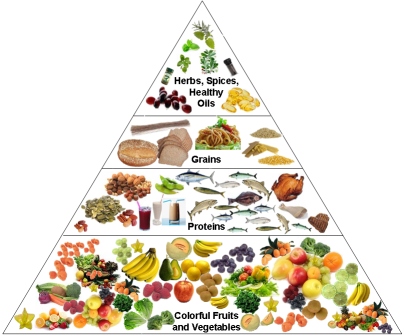Nutrition
Introduction[edit | edit source]
Good nutrition, physical activity, and healthy body weight are essential parts of a person’s overall health and well-being. Together, these can help decrease a person’s risk of developing serious health conditions, such as high blood pressure, high cholesterol, diabetes, heart disease, stroke, and cancer. A healthful diet, regular physical activity, and achieving and maintaining a healthy weight also are paramount to managing health conditions so they do not worsen over time.[1]
According to the World Health Organization:
- Nutrition is the intake of food considered in relation to the body’s dietary needs. Good nutrition – an adequate, well-balanced diet combined with regular physical activity – is a cornerstone of good health. Poor nutrition can lead to reduced immunity, increased susceptibility to disease, impaired physical and mental development and reduced productivity[2]
Importance - Good Nutrition[edit | edit source]
Consuming a healthy diet throughout the life course helps prevent malnutrition in all its forms as well as a range of noncommunicable diseases and conditions.
- The increased production of processed food, rapid urbanization and changing lifestyles have led to a shift in dietary patterns.
- People are consuming more foods high in energy, fats, free sugars or salt/sodium, and many do not eat enough fruit, vegetables and dietary fibre such as whole grains.
- The exact make-up of a diversified, balanced and healthy diet will vary depending on the individual needs (e.g. age, gender, lifestyle, degree of physical activity), cultural context, locally available foods and dietary customs. But basic principles of what constitutes a healthy diet remain the same.
Important Facts
- A healthy diet helps protect against malnutrition in all its forms, as well as noncommunicable diseases (NCDs) eg. diabetes, heart disease, stroke and cancer.
- Unhealthy diet and lack of physical activity are leading global risks to health.
- Healthy dietary practices start early in life – breastfeeding fosters healthy growth and improves cognitive development, and may have longer-term health benefits, like reducing the risk of becoming overweight or obese and developing NCDs later in life.
- Energy intake (calories) should be in balance with energy expenditure: total fat should not exceed 30% of total energy intake to avoid unhealthy weight gain; intake of saturated fats should be less than 10 % of total energy intake; trans-fats to less than 1% of total energy intake, with a shift in fat consumption away from saturated fats and trans-fats to unsaturated fats, and towards the elimination of industrial trans fats.
- Limiting intake of free sugars to less than 10% of total energy intake is part of a healthy diet. A further reduction to less than 5% of total energy intake is suggested for additional health benefits.
- Keeping salt intake to less than 5 g per day helps prevent hypertension and reduces the risk of heart disease and stroke in the adult population.
- WHO Member States have agreed to reduce the global population’s intake of salt by 30% and halt the rise in diabetes and obesity in adults and adolescents as well as in childhood overweight by 2025[3].
Healthy Diet Basics[edit | edit source]
Eat a variety of foods
- Eat a combination of different foods, including staple foods (e.g. cereals such as wheat, barley, rye, maize or rice, or starchy tubers or roots such as potato, yam, taro or cassava), legumes (e.g. lentils, beans), vegetables, fruit and foods from animals sources (e.g. meat, fish, eggs and milk)
Why?
- Eating a variety of whole (i.e. unprocessed) and fresh foods every day helps children and adults to obtain the right amounts of essential nutrients. It also helps them to avoid a diet that is high in sugars, fats and salt, which can lead to unhealthy weight gain (i.e. overweight and obesity) and non-communicable diseases. Eating a healthy, balanced diet is especially important for young children's development; it also helps older people to have healthier and more active lives.
Eat plenty of vegetables and fruit
- Eat a wide variety of vegetables and fruit
- For snacks, choose raw vegetables and fresh fruit, rather than foods that are high in sugars, fats or salt
- Avoid overcooking vegetables and fruit as this can lead to the loss of important vitamins
- When using canned or dried vegetables and fruit, choose varieties without added salt and sugars
Why?
- Vegetables and fruit are important sources of vitamins, minerals, dietary fibre, plant protein and antioxidants. People whose diets are rich in vegetables and fruit have a significantly lower risk of obesity, heart disease, stroke, diabetes and certain types of cancer.
Eat moderate amounts of fats and oils
- Use unsaturated vegetable oils (e.g. olive, soy, sunflower or corn oil) rather than animals fats or oils high in saturated fats (e.g. butter, ghee, lard, coconut and palm oil)
- Choose white meat (e.g. poultry) and fish, which are generally low in fats, in preference to red meat
- Eat only limited amounts of processed meats because these are high in fat and salt
- Where possible, opt for low-fat or reduced-fat versions of milk and dairy products
- Avoid processed, baked and fried foods that contain industrially produced trans-fat
Why?
- Fats and oils are concentrated sources of energy, and eating too much fat, particularly the wrong kinds of fat, can be harmful to health. For example, people who eat too much saturated fat and trans fat are at higher risk of heart disease and stroke. Trans-fat may occur naturally in certain meat and milk products, but the industrially produced trans-fat (e.g. partially hydrogenated oils) present in various processed foods is the main source.
Eat less salt and sugars
- When cooking and preparing foods, limit the amount of salt and high-sodium condiments (e.g. soy sauce and fish sauce)
- Avoid foods (e.g. snacks), that are high in salt and sugars
- Limit intake of soft drinks or soda and other drinks that are high in sugars (e.g. fruit juices, cordials and syrups, flavoured milk and yoghurt drinks)
- Choose fresh fruits instead of sweet snacks such as cookies, cakes and chocolate
Why?
- People whose diets are high in sodium (including salt) have a greater risk of high blood pressure, which can increase their risk of heart disease and stroke. Similarly, those whose diets are high in sugars have a greater risk of becoming overweight or obese, and an increased risk of tooth decay. People who reduce the number of sugars in their diet may also reduce their risk of noncommunicable diseases such as heart disease and stroke[4].
Nutrition and Physiotherapy[edit | edit source]
Nutrition can directly affect recovery and function while an individual is under a physical therapist's care. Thus, PTs should be concerned with and address the nutritional intake and eating patterns of their patients and clients.
Science is increasingly showing just how critical nutrition is to healing and recovery. As we know during a state of trauma, such as injury or surgery, the body’s nutritional needs increase:
- The body enters a higher metabolic state and requires more energy
- Trauma and lack of use lead to muscle atrophy, which prolongs recovery
- The immune system is weakened due to stress and shock
- Risk of wound infection is increased
- Persistent inflammation delays the return of function
- Trauma and physiological stress lead to increased fatigue[5]
Nutritional deficiencies impede the natural progression of healing, including elevating the risk of infection and lengthening recovery periods. A patient that is nutritionally optimized will heal better and faster and have better long-term outcomes. One that isn’t will heal more poorly and more slowly and may have long-term complications.[6]
Physical therapists/ Physiotherapists are committed to improving and promoting wellness[7], general health, lifestyle and quality of life.
- They are well-positioned as established healthcare practitioners, to provide clinically relevant patient education on the long-term health benefits of good nutrition which may include eg behaviour changes to improve their general health and physical therapy outcomes.[8]
- To manage a patient as a whole with a holistic approach physiotherapists need to have basic knowledge about the role of nutrition, as well as understand the effects of a successful behaviour change.
- see also Muscle Strength and Protein
Physiotherapist's Role in Providing Specific Nutritional or Dietary Advice[edit | edit source]
- Patient's diet has an effect on muscle function and muscle function is one of the key concerns in physical therapy practice.[9] Physiotherapists have the scope of knowing the patient's nutritional status which creates an opportunity to refer a patient to nutritionists when needed.[10]
- One randomized trial on patients with osteopenia or osteoporosis found nutrition supplementation in combination with exercise to be more effective in reducing the risk of falling than nutrition alone.[11] Another study suggests multidimensional interventions including nutrition and physical training being effective in reducing frailty in geriatric people.[12]
- Physical therapists/ Physiotherapists without the necessary nutrition-related education are not allowed to give dietary advice, but play a vital role in the screening and referring of patients that are in need of dietary advice or who can benefit from it. Many conditions managed and seen by physiotherapists are directly affected by diet and nutrition.
References[edit | edit source]
- ↑ ODPHP Nutrition, Physical Activity, and Obesity Available from:https://www.healthypeople.gov/2020/leading-health-indicators/2020-lhi-topics/Nutrition-Physical-Activity-and-Obesity (last accessed 15.10.2020)
- ↑ World Health Organization. Nutrition. Available at: http://www.emro.who.int/health-topics/nutrition/index.html. [Last accessed: 26 September 2020]
- ↑ World Health Organization. Healthy diet. World Health Organization. Regional Office for the Eastern Mediterranean; 2019.Available from:https://www.who.int/publications/m/item/healthy-diet-factsheet394 (last accessed 15.10.2020)
- ↑ WHO 5 keys to a healthy diet Available from:https://www.who.int/nutrition/topics/5keys_healthydiet/en/ (last accessed 15.10.2020)
- ↑ MEND PT and nutrition https://mend.me/physical-therapy-and-nutritiona-practitioners-guide/ (last accessed 15.10.2020)
- ↑ American Physical Therapy Association (APTA). Role Of PT Diet Nutrition. Available at: https://www.apta.org/apta-and-you/leadership-and-governance/policies/role-of-pt-diet-nutrition. [Last accessed: 26 September 2020]
- ↑ Burniston J, Eftekhari F, Hrabi S, Worsley R, Dean E. Health behaviour change and lifestyle-related condition prevalence: Comparison of two epochs based on systematic review of the physical therapy literature. Hong Kong Physiotherapy journal. 2012. Vol 30. Pg 44-56.
- ↑ Alexander J, Bambury E, Mendoza A, Reynolds J, Veronneau R, Dean E. Health education strategies used by physical therapists to promote behavioural change in people with lifestyle-related conditions: A systematic review. Hong Kong Physiotherapy journal. 2012. Vol 30. Pg 57-75.
- ↑ Phadke CP. Why Should Physical Therapists Care about Their Patients' Diet? Physiother Can. 2017. p99-103.
- ↑ Morris DM, Kitchin EM, Clark DE. Strategies for optimizing nutrition and weight reduction in physical therapy practice: The evidence. Physiotherapy Theory and Practice. 2009 Jan 1;25(5-6):408-23.
- ↑ Swanenburg J, de Bruin ED, Stauffacher M, Mulder T, Uebelhart D. Effects of exercise and nutrition on postural balance and risk of falling in elderly people with decreased bone mineral density: a randomized controlled trial pilot study. Clinical rehabilitation. 2007 Jun;21(6):523-34.
- ↑ Veninšek G, Gabrovec B. Management of frailty at individual level–clinical management: Systematic literature review. Slovenian Journal of Public Health. 2018 Apr 12;57(2):106-15.









